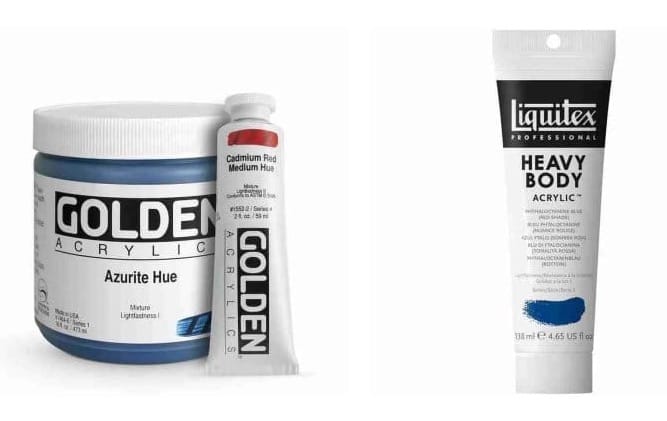Top Acrylic Paint for Beginners and Professionals
No more cardboard “steak” choices. Skip hype, choose pigment. Beginner and pro acrylic picks, body types explained, and the 8-color palette that makes mixing easy.

Looking for the top acrylic paint? It doesn’t have to be a Cheez-Whiz experience—here’s how to skip hype and buy pigment that actually performs. Let me explain...
Seven hour road trip...with three kids. Chips and Goldfish for lunch. We finally hit Lititz, PA, ditched the café we’d researched, and followed a packed parking lot to a random sandwich shop. First bite? Steak-ums + Cheez-Whiz. Cardboard wrapped in fake cheese. Lesson: crowds and star ratings can lie. Ingredients matter.
Looking for a free acrylic course and more resources? Visit the Acrylic Hub →
Paint’s the same. Ignore the hype and choose acrylics with real pigment load, honest handling, and clean mixes. Here’s what to buy now—beginner to pro—and why.

TL;DR Picks
Beginner (value, clean mixes)
- Liquitex BASICS – smooth, consistent workhorse for learning.
- Winsor & Newton Galeria – a touch thicker; reliable range.
- Blick Studio Acrylics – budget, dependable color for reps.
Artist-grade (what I reach for)
- Liquitex Professional Heavy Body – buttery, predictable; great brush/knife feel.
- Golden Heavy Body – high pigment load; strokes “stand up,” mixes stay punchy.
- Utrecht Artists’ Acrylic – pro performance at a friendlier price.
Specialty
- Golden OPEN – slow-dry for blending and softer transitions.
- Golden Fluid / High Flow – thin body, high chroma for glazes/detail.
- Golden SoFlat – ultra-matte, graphic finish.
Start with 8 colors (see list below) and a big Titanium White. Master mixes before buying a wall of tubes.
The Lititz Lesson
Just like that “steak sandwich,” some paints look popular but are stuffed with extenders and dyes. What you want:
- Pigment load: strong tinting strength, fewer passes to reach color.
- Binder quality: durable film, not chalky when thinned.
- Clear labeling: pigment codes (e.g., PR122), lightfastness, fewer “Hue” substitutes.
Student vs. Artist Grade
- Pigment: more in artist grade → cleaner mixes, stronger color.
- Fillers: fewer in artist grade → less chalk/mud.
- Lightfastness: artist lines document permanence clearly.
- When student grade is fine: drills, classes, big under-paintings.
- When to upgrade: when mixes turn gray too fast or you’re fighting weak color.
Body & Dry Time
- Heavy-body: thick, holds marks (Liquitex Pro HB, Golden HB).
- Fluid / High-Flow: thinner body, same punch (glazes, detail).
- OPEN: slow-dry window for smoother blends.
A Beginner Palette That Beats a 48-Pack
- Titanium White
- Hansa/Azo Yellow Medium
- Alizarin Crimson
- Cadmium Red Light
- Cobalt Blue
- Ultramarine Blue
- Yellow Ochre
- Burnt Sienna
Fast mix wins:
Cobalt + Hansa = vibrant greens · Alizarin crimson + Ultramarine = clean violets · Burnt Sienna + Ultramarine = instant neutrals

What I Use
Liquitex Professional Heavy Body
Why: buttery, predictable handling; great for alla prima and knife work.
Use when: you want control without fighting the paint.
Golden Heavy Body
Why: serious pigment, crisp edges, strokes that “stand.”
Use when: you want maximum snap and strong, clean mixes.
(Value lane) BASICS / Galeria / Blick Studio: ideal for practice and volume. Favor single-pigment primaries to keep mixes clean.
Smart Buying
Skip the parking-lot trap...
- Buy 59–75 ml tubes; go big on PW6.
- Add colors only when a mix keeps failing.
- Test 2–3 brands side-by-side, same swatches.
- Sets are convenient, but pre-picked hues = less control. Build your own.
Storage & Care
- Cool, dry, out of sun; don’t let acrylics freeze.
- Wipe threads, cap tightly; skins = wasted paint.
- Brush soap > dish soap; dispose of rinse water responsibly (don’t dump pigment down drains).
Wrap
Don’t order the Cheez-Whiz paint. Choose honest pigment, a tight palette, and the body that matches how you paint. Your mixes—and your paintings—will taste a lot better.
Learn & Improve Your Acrylic Skills
- Acrylic Hub– Your go-to guide for tutorials, tips, and resources.
- Subscribe for More Great Content - Get tutorials, tips, and updates straight to your inbox.
- Follow Me on Pinterest - Daily inspiration, tips, and fresh ideas.




